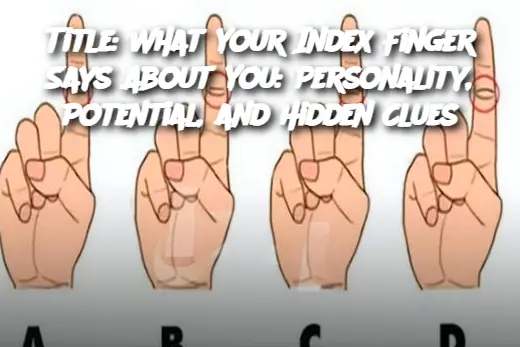-
Compare Finger Length Ratios:
-
Lay your hand flat and compare the length of your index (pointer) finger to your ring finger.
-
Longer Index Finger: Often linked to confidence, leadership qualities, and decisiveness.
-
Shorter Index Finger: Believed to be connected to analytical thinking, independence, and high self-awareness.
-
Equal Length: Suggests balance, diplomacy, and strong adaptability.
-
-
Check Hand Dominance:
-
The dominant hand is said to reflect your current behavior and actions.
-
The non-dominant hand may hint at natural potential, inner strengths, or personal evolution.
-
-
Observe Flexibility and Shape:
-
A very straight index finger may suggest discipline and determination.
-
A slightly curved finger could point to empathy, sensitivity, or a creative nature.
-
-
Look at Nail Shape:
-
Long, narrow nails might reflect a refined, artistic personality.
-
Shorter or wider nails could indicate practicality and directness.
-
-
Examine Skin Lines or Marks:
-
Some palmistry interpretations suggest that unique lines at the base of the index finger (Mount of Jupiter) are linked to ambition and personal power.
-
Serving and Storage Tips (Applying These Insights):
-
Use for Self-Reflection: Let these traits guide your career choices, communication style, or relationship dynamics.
-
Keep an Open Mind: While interesting, these observations should complement—not replace—personal growth, therapy, or professional advice.
-
Journal Your Observations: Keep a small record of your self-assessments and how they align with real-life experiences.
Variants (Other Hands & Fingers to Explore):
-
Ring Finger (Apollo): Often associated with creativity, charisma, and emotional expression.
-
Thumb (Willpower): Considered the finger of determination and drive.
-
Little Finger (Mercury): Linked to communication, intuition, and emotional intelligence.
-
Palm Lines: Explore heart line, head line, and life line for broader character interpretations.
FAQ:
Q: Is there scientific evidence that finger length relates to personality?
A: Some studies have explored the 2D:4D ratio (index vs. ring finger length) and its possible links to hormone exposure in the womb, which may correlate with certain traits. However, findings are not conclusive.
Q: Which hand should I use for finger analysis?
A: Traditionally, the dominant hand reflects your present personality and how you interact with the world, while the non-dominant hand may reveal subconscious traits or potential.
Q: Can finger shape really predict the future?
A: Predicting the future based on finger traits is more symbolic than scientific. It’s better viewed as a tool for introspection or curiosity rather than fate.
Q: What if my index finger is bent or injured?
A: Physical differences don’t change your worth or abilities. Focus on the broader symbolism rather than specifics if your finger has been altered by injury or genetics.
Q: Is this the same as palm reading?
A: It’s related! Finger analysis is often a component of palmistry, which includes interpreting finger shapes, mounts, and palm lines for insight into personality and destiny.
Conclusion:
While not a science, the idea that your index finger holds keys to your personality and potential is a fascinating blend of tradition, psychology, and observation. Whether you’re a skeptic or a believer, examining your hands can be a powerful way to pause, reflect, and perhaps even discover a little more about who you are—and who you might become.
